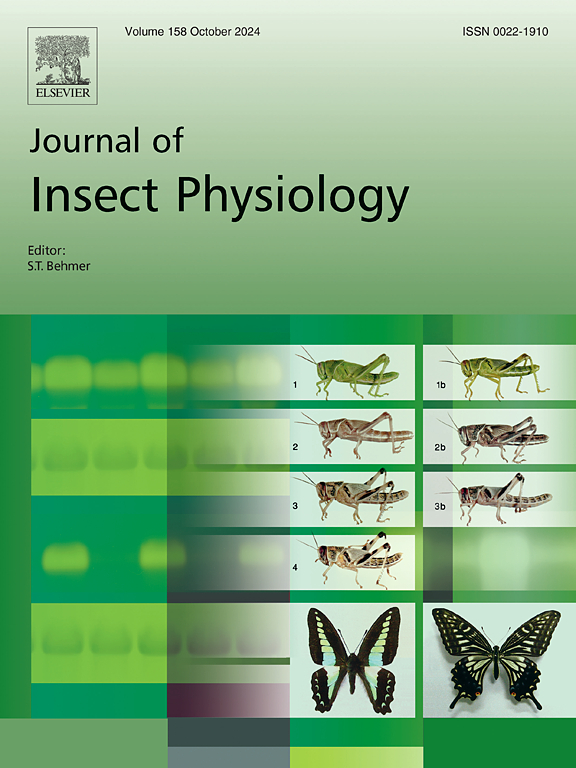LmCHS1 mediates pro-nymphal cuticle formation in Locusta migratoria embryogenesis
IF 2.3
2区 农林科学
Q1 ENTOMOLOGY
引用次数: 0
Abstract
The pro-nymphal cuticle, serving as a protective structure that facilitates environmental adaptation, is critical for insect embryonic development. However, the mechanisms governing its formation remain poorly understood. In this study, we investigated the important role of chitin synthase (LmCHS1) in the formation of the pro-nymphal cuticle during embryonic development in Locusta migratoria. The pro-nymphal cuticle begins to form in 8-day-old embryos (E8) and undergoes degradation by E12, coinciding with the preparatory phase (E13-E14) for hatching of the first-instar nymph. Spatiotemporal expression analysis indicated that LmCHS1 mRNA levels are elevated before cuticle formation, with protein localization peaking at the plasma membrane during active chitin synthesis (E8-E11). Targeting LmCHS1 through embryonic RNA interference (RNAi) resulted in developmental failures during late embryogenesis. Additionally, ultrastructural analysis confirmed that silencing LmCHS1 disrupts the normal chitin structure in the pro-nymphal cuticle. Further investigation into the ecological function of LmCHS1 in adapting the pro-nymphal cuticle to dry environments revealed that the tolerance of embryo to various dry conditions is significantly reduced after konckdown of LmCHS1. In summary, these findings highlight the essential role of chitin synthase in the formation of the pro-nymphal cuticle in locust embryos, underscoring its importance in embryonic development and adaptation to environmental challenges like desiccation.
LmCHS1介导迁徙蝗胚胎发生过程中淋巴前角质层的形成
前若虫角质层作为一种保护结构,促进环境适应,对昆虫胚胎发育至关重要。然而,控制其形成的机制仍然知之甚少。在本研究中,我们研究了几丁质合成酶(LmCHS1)在迁徙蝗胚胎发育过程中淋巴前角质层形成中的重要作用。前若虫角质层在8天大的胚胎(E8)开始形成,并经过E12的降解,与一龄若虫孵化的准备阶段(E13-E14)一致。时空表达分析表明,在角质层形成之前,LmCHS1 mRNA水平升高,在活性几丁质合成期间,蛋白定位在质膜处达到峰值(E8-E11)。通过胚胎RNA干扰(RNAi)靶向LmCHS1导致胚胎发生晚期发育失败。此外,超微结构分析证实,沉默LmCHS1会破坏淋巴前角质层正常的几丁质结构。进一步研究LmCHS1在前淋巴角质层适应干燥环境中的生态功能发现,敲除LmCHS1后,胚胎对各种干燥条件的耐受性显著降低。总之,这些发现强调了几丁质合成酶在蝗虫胚胎中形成前淋巴角质层的重要作用,强调了它在胚胎发育和适应干燥等环境挑战中的重要性。
本文章由计算机程序翻译,如有差异,请以英文原文为准。
求助全文
约1分钟内获得全文
求助全文
来源期刊

Journal of insect physiology
生物-昆虫学
CiteScore
4.50
自引率
4.50%
发文量
77
审稿时长
57 days
期刊介绍:
All aspects of insect physiology are published in this journal which will also accept papers on the physiology of other arthropods, if the referees consider the work to be of general interest. The coverage includes endocrinology (in relation to moulting, reproduction and metabolism), pheromones, neurobiology (cellular, integrative and developmental), physiological pharmacology, nutrition (food selection, digestion and absorption), homeostasis, excretion, reproduction and behaviour. Papers covering functional genomics and molecular approaches to physiological problems will also be included. Communications on structure and applied entomology can be published if the subject matter has an explicit bearing on the physiology of arthropods. Review articles and novel method papers are also welcomed.
 求助内容:
求助内容: 应助结果提醒方式:
应助结果提醒方式:


